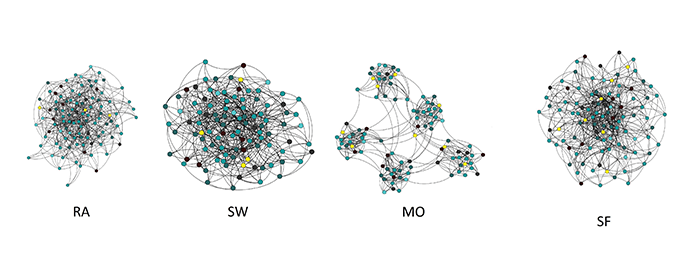How do we as individuals learn from our social networks? From whom within our communities is it best to learn? And what makes some communities more innovative than others?
These are some of the questions Ali Minai, Ph.D., a University of Cincinnati professor in the Department of Electrical Engineering and Computing Systems, is trying to answer. Using a multi-agent systems model on the Oakley Cluster at the Ohio Supercomputer Center (OSC), Minai and his Ph.D. student, Marwa Shekfeh, are performing simulations that will help us understand how individuals build knowledge and generate ideas through their social networks.
“There are two ways we can answer these questions,” said Minai, who has a background in complex systems and computational neuroscience. “One is field work, in which we go out and try to find real-world social networks where this process is going on; that is incredibly difficult to do in a controlled way. The alternative is to do it through simulation, and that’s why we need high performance computing.
“In our model, each individual has their own knowledge, which consists of many facts associated with each other. We want to simulate hundreds, thousands, even tens of thousands of individuals. For this to be even somewhat meaningful, we have to model the mental processes of each individual in a simple but plausible way. We look at how patterns of social connectivity and whom agents attend to influence collective learning and creativity.”
To gain insight for the multi-agent systems model, Minai collaborates with a group, including psychologists at the University of Texas at Arlington who study individuals in group settings. Minai and other group researchers at Stony Brook University and Hofstra University also look at data such as scientific publications where researchers cite the work of other researchers systematically.
“If you look at the work of hundreds or thousands of researchers within a field, you can often find out who was influenced by whom and to what extent,” he said.
“The implications are huge depending on what we find. The results could be relevant for education and public policy, and even for situations such as teams working on projects within corporations or research labs. Though creativity is often seen as a solitary activity, in fact it depends strongly on social factors. We hope our models can help clarify this and enhance prospects for systematic innovation.”
###
Written by Ross Bishoff
Project Lead: Ali Minai, Ph.D., University of Cincinnati
Research Title: Multi-agent system model of collective learning and creativity
Funding Source: National Science Foundation (INSPIRE Award)
Website: www.ece.uc.edu/~aminai

